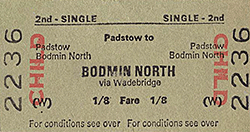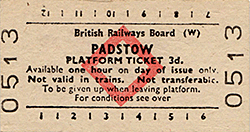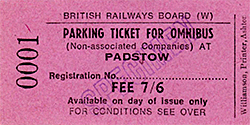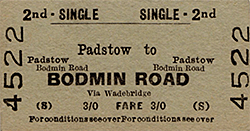|
 |
 |
 |
 |
 |
 |
old106.jpg) A general view of Padstow station in August 1960. Beneath the canopy on this occasion the platform is rather cluttered with barrows, a ladder and other objects. Just visible is the variations in lamp standards which prevailed at this time. That on the near end of the platform is rather higher than that towards the far end of the platform and which has a different style of neck. That directly ahead of the camera and largely invisible due to the light on the sloping roof also appears shorter. On the right
A general view of Padstow station in August 1960. Beneath the canopy on this occasion the platform is rather cluttered with barrows, a ladder and other objects. Just visible is the variations in lamp standards which prevailed at this time. That on the near end of the platform is rather higher than that towards the far end of the platform and which has a different style of neck. That directly ahead of the camera and largely invisible due to the light on the sloping roof also appears shorter. On the right
is a stabled Bulleid set.
Copyright photo from John Alsop collection
old90.jpg)
old94.jpg)
old89.jpg)
onto the wrong track.
old117.jpg) This August 1960 view is titled 'Arrival of The Atlantic Coast Express' but in fact it has already arrived and the locomotive is reversing out of the station and will proceed to the turntable, partially visible to the right of the water tower with its mysterious brick structure. Despite the wonders of modern technology, the Bulleid Pacific remains unidentified. The ACE may or may not have appeared at Padstow carrying a headboard and some sources suggest an ACE without a headboard was common on Saturdays as on that day the train was not officially named. While this may sound like poppycock, the answer may lay in the fact that the train was extremely busy on summer Saturdays and could run from/too Waterloo as several totally separate trains. The headcode seen in this view applied to the Exeter (Central) - Padstow section. Between Waterloo and Exeter and vice versa the headcode was top centre and bottom centre; portions of the train west of Exeter would carry the headcode applicable to that section. Disc headcodes applied during daylight hours; lamps were substituted when all or part of a journey was during the hours of darkness and this applied anywhere, not just on the ACE. Some photographs of the ACE at Padstow within these pages show it bearing lamps instead of discs. The signal seen in this view applied to the platform road and the Bulleid will be under the control of shunt signals. At this time the sight of a steam locomotive, or indeed the ACE, was nothing worthy of a second glance, so one wonders what is grabbing the attention of the people on the platform. The most likely answer is the turntable. Watching a locomotive being turned grabbed the attention of people of all ages, especially those who did not live near an engine shed or see regularly this aspect of railway operation.
This August 1960 view is titled 'Arrival of The Atlantic Coast Express' but in fact it has already arrived and the locomotive is reversing out of the station and will proceed to the turntable, partially visible to the right of the water tower with its mysterious brick structure. Despite the wonders of modern technology, the Bulleid Pacific remains unidentified. The ACE may or may not have appeared at Padstow carrying a headboard and some sources suggest an ACE without a headboard was common on Saturdays as on that day the train was not officially named. While this may sound like poppycock, the answer may lay in the fact that the train was extremely busy on summer Saturdays and could run from/too Waterloo as several totally separate trains. The headcode seen in this view applied to the Exeter (Central) - Padstow section. Between Waterloo and Exeter and vice versa the headcode was top centre and bottom centre; portions of the train west of Exeter would carry the headcode applicable to that section. Disc headcodes applied during daylight hours; lamps were substituted when all or part of a journey was during the hours of darkness and this applied anywhere, not just on the ACE. Some photographs of the ACE at Padstow within these pages show it bearing lamps instead of discs. The signal seen in this view applied to the platform road and the Bulleid will be under the control of shunt signals. At this time the sight of a steam locomotive, or indeed the ACE, was nothing worthy of a second glance, so one wonders what is grabbing the attention of the people on the platform. The most likely answer is the turntable. Watching a locomotive being turned grabbed the attention of people of all ages, especially those who did not live near an engine shed or see regularly this aspect of railway operation.old88.jpg)
Photo from John Mann collection
old83.jpg)
Photo by G Parr
old39.jpg)
Photo by David Pearson
old38.jpg)
old41.jpg) Drummond T9 No.30313, one of the class members with wide splashers, has arrived at Padstow. This locomotive was an Exmouth Junction resident from August 1959 until withdrawal came in July 1961, thus providing a dating window for this photograph. Maunsell coaching stock prevails. No.30313 having arrived with set 27. This set comprised Brake Second (formerly Third) S3775S and Brake Composite S6603S. It was one of those classified as 'P sets' and intended for use as dividing portions for West of England branches from main line trains to and from Waterloo. In practice during BR days they seem to have spent most of their time pottering around the West Country on local services.
Drummond T9 No.30313, one of the class members with wide splashers, has arrived at Padstow. This locomotive was an Exmouth Junction resident from August 1959 until withdrawal came in July 1961, thus providing a dating window for this photograph. Maunsell coaching stock prevails. No.30313 having arrived with set 27. This set comprised Brake Second (formerly Third) S3775S and Brake Composite S6603S. It was one of those classified as 'P sets' and intended for use as dividing portions for West of England branches from main line trains to and from Waterloo. In practice during BR days they seem to have spent most of their time pottering around the West Country on local services.
Copyright photo from Colour-Rail
old122.jpg) Ex-GWR locomotives at Padstow tend to be associated with the post 1963 period when lines in the area, excepting the Bodmin Road - Bodmin General section which always was GWR, came under the control of BR Western Region but this was not the case. Elsewhere the process had begun in 1958 as a result of boundary changes but in November 1959 two ex-GWR pannier tanks were sent to Exmouth Junction, then still a Southern shed. One was No.4666 and the other No.4694, both being members of the GWR 5700 class. In December 1959 both were reallocated to Wadebridge Shed, apparently for trials on the Bodmin North - Padstow section, where they remained until moved back to Exmouth Junction in February 1963 so the photograph of No.4666 at Padstow likely dates from that period. It should, however, be remembered that whilst resident at Exmouth Junction both are likely to have continued to visit Wadebridge if not Padstow. In this view No.4666 waits at Padstow with one of the ex-Southern Maunsell sets on a service to Bodmin, presumably Bodmin North. On the right a Southern Bulleid coach can be seen stabled, perhaps part of an Atlantic Coast Express set. The Southern system of headcode discs used six positions; one in front of the chimney, one either side of the smokebox and three on the bufferbeam and in this respect the operation of ex-GWR locomotives on former Southern metals is something of a mystery. Just visible in this view is an iron to the right of the smokebox door but apparently without the corresponding iron on the opposite side. A photograph has been seen showing No.4666 legging-it from Launceston in the direction of Wadebridge with a disc in position to the right of its smokebox, but it seems the adaption of ex-GWR locomotives to the Southern headcode system was very much a half-hearted affair. The various types of GWR pannier tanks, so named because of the water tank positions either side of the boiler, were prolific and the 5700 class alone totalled 863 examples. Of these, some were sold to the National Coal Board whilst better known is the batch sold to London Transport and the final examples of which continued in service until 1971. Of those which went on to serve at collieries, the final example is believed to have remained in service until 1975. A number of the 5700 class have survived into preservation but Nos.4666 and 4694 are not among them, both being withdrawn in June 1965 and scrapped. A few of the class, officially three but in actuality four, went on to become the final ex-GWR steam locomotives in BR service being withdrawn in October 1966 from Croes Newydd, by that time a London Midland Region shed and located at Wrexham. Other pannier tanks at Wadebridge shed were three members of the 1366 class; outside cylinder types which had been transferred from Weymouth in 1962 to replace the Beatties. Of these, one, No.1369, has survived into preservation. The Wenford branch, duty 637, was operated by Wadebridge shed's No.1 link which also included trips to Padstow, as did No.5 link, the Wadebridge pilot, but to date no evidence has come to light of the 1366 class actually appearing at Padstow. Some anecdotes have survived concerning the reaction of the ex-Southern Wadebridge men to the arrival of the ex-GWR pannier tanks, albeit a little contradictory. The usual disdain towards 'foreign' locomotives applied plus a view that the panniers were rough-riding, lumbering machines fit only for shunting. The latter grumble, however, was probably no more than an attempt to justify the former. On the plus side, it is said the panniers were popular due to their higher, relative to the Beatties, coal and water capacity as this made the crew's job easier and especially on the Wenford branch where, providing Wadebridge was departed with full tanks, the traditional water stop at Penhargard could be omitted. Perhaps this was just as well because the tank at Penhargard was suited to the well tanks of the Beatties but problems were encountered with the much higher water tanks of the panniers
Ex-GWR locomotives at Padstow tend to be associated with the post 1963 period when lines in the area, excepting the Bodmin Road - Bodmin General section which always was GWR, came under the control of BR Western Region but this was not the case. Elsewhere the process had begun in 1958 as a result of boundary changes but in November 1959 two ex-GWR pannier tanks were sent to Exmouth Junction, then still a Southern shed. One was No.4666 and the other No.4694, both being members of the GWR 5700 class. In December 1959 both were reallocated to Wadebridge Shed, apparently for trials on the Bodmin North - Padstow section, where they remained until moved back to Exmouth Junction in February 1963 so the photograph of No.4666 at Padstow likely dates from that period. It should, however, be remembered that whilst resident at Exmouth Junction both are likely to have continued to visit Wadebridge if not Padstow. In this view No.4666 waits at Padstow with one of the ex-Southern Maunsell sets on a service to Bodmin, presumably Bodmin North. On the right a Southern Bulleid coach can be seen stabled, perhaps part of an Atlantic Coast Express set. The Southern system of headcode discs used six positions; one in front of the chimney, one either side of the smokebox and three on the bufferbeam and in this respect the operation of ex-GWR locomotives on former Southern metals is something of a mystery. Just visible in this view is an iron to the right of the smokebox door but apparently without the corresponding iron on the opposite side. A photograph has been seen showing No.4666 legging-it from Launceston in the direction of Wadebridge with a disc in position to the right of its smokebox, but it seems the adaption of ex-GWR locomotives to the Southern headcode system was very much a half-hearted affair. The various types of GWR pannier tanks, so named because of the water tank positions either side of the boiler, were prolific and the 5700 class alone totalled 863 examples. Of these, some were sold to the National Coal Board whilst better known is the batch sold to London Transport and the final examples of which continued in service until 1971. Of those which went on to serve at collieries, the final example is believed to have remained in service until 1975. A number of the 5700 class have survived into preservation but Nos.4666 and 4694 are not among them, both being withdrawn in June 1965 and scrapped. A few of the class, officially three but in actuality four, went on to become the final ex-GWR steam locomotives in BR service being withdrawn in October 1966 from Croes Newydd, by that time a London Midland Region shed and located at Wrexham. Other pannier tanks at Wadebridge shed were three members of the 1366 class; outside cylinder types which had been transferred from Weymouth in 1962 to replace the Beatties. Of these, one, No.1369, has survived into preservation. The Wenford branch, duty 637, was operated by Wadebridge shed's No.1 link which also included trips to Padstow, as did No.5 link, the Wadebridge pilot, but to date no evidence has come to light of the 1366 class actually appearing at Padstow. Some anecdotes have survived concerning the reaction of the ex-Southern Wadebridge men to the arrival of the ex-GWR pannier tanks, albeit a little contradictory. The usual disdain towards 'foreign' locomotives applied plus a view that the panniers were rough-riding, lumbering machines fit only for shunting. The latter grumble, however, was probably no more than an attempt to justify the former. On the plus side, it is said the panniers were popular due to their higher, relative to the Beatties, coal and water capacity as this made the crew's job easier and especially on the Wenford branch where, providing Wadebridge was departed with full tanks, the traditional water stop at Penhargard could be omitted. Perhaps this was just as well because the tank at Penhargard was suited to the well tanks of the Beatties but problems were encountered with the much higher water tanks of the panniers
old62.jpg)
Photo from Malcolm McCarthy collection
old108.jpg)
Click here for Padstow Gallery 8: May 1962 - c1964

|
| Last updated: Wednesday, 07-Mar-2018 14:50:27 CET | © 1998-2016 Disused Stations |

 Home Page
Home Page